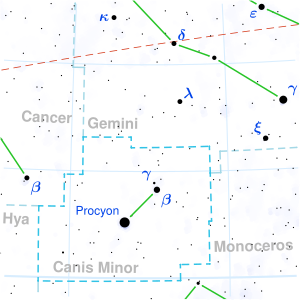Luyten's Star
Location of Luyten's Star in the constellation Canis Minor | |
| Observation data Epoch J2000 Equinox J2000 | |
|---|---|
| Constellation | Canis Minor |
| Right ascension | 07h 27m 24.49897s[1] |
| Declination | +05° 13′ 32.8415″[1] |
| Apparent magnitude (V) | 9.872[2] |
| Characteristics | |
| Spectral type | M3.5V[3] |
| U−B color index | 1.115[2] |
| B−V color index | 1.571[2] |
| Variable type | None |
| Absolute magnitude (MV) | 11.94[2] |
| Details Gyr | |
MCC 17[7] | |
| Database references | |
| SIMBAD | data |
Luyten's Star
Properties
This star is approximately a quarter the mass of the
At present, Luyten's Star is moving away from the
Planetary system
| Companion (in order from star) |
Mass | Semimajor axis (AU) |
Orbital period (days) |
Eccentricity | Inclination | Radius |
|---|---|---|---|---|---|---|
| c | ≥1.18±0.16 M🜨 | 0.036467±0.000002 | 4.7234±0.0004 | 0.17+0.13 −0.12 |
~72°–90[b]° | — |
| b | ≥2.89+0.27 −0.26 M🜨 |
0.091101+0.000019 −0.000017 |
18.6498+0.0059 −0.0052 |
0.10+0.09 −0.07 |
~72°–90[b]° | — |
| d (unconfirmed) | ≥10.8+3.9 −3.5 M🜨 |
0.712+0.062 −0.076 |
413.9+4.3 −5.5 |
0.17+0.18 −0.17 |
~72°–90° | — |
| e (unconfirmed) | ≥9.3+4.3 −3.9 M🜨 |
0.849+0.083 −0.092 |
542±16 | 0.03+0.20 −0.03 |
~72°–90° | — |
In March 2017, two candidate planets were discovered orbiting Luyten's Star.
GJ 273b is one of the closest known planets in its star's habitable zone.[9]
Both planets are near 4:1 resonance; it is possible that, with still undiscovered ones, the entire inner part of this system is trapped in a single simple-mean-motion resonance chain like TRAPPIST-1.
In 2019, two more candidate planets were detected by radial velocity, making a potential total of four known planets in the system.[19] If all four planets are present, their true masses must be close to their minimum masses for the system to be stable, with upper limits of 3.03 M🜨 for b, 1.24 M🜨 for c, 11.35 M🜨 for d, and 9.70 M🜨 for e.[4]
In October 2017, "
See also
Notes
- ^ This is denoted by v sin i, where v is the rotational velocity at the equator and i is the inclination to the line of sight.
- ^ a b In a solution with 2 planets around Luyten's Star for Luyten b and Luyten c, the system was unstable when the inclination was below 50° and the planets were on very eccentric orbits. However, with lower eccentricities, the 2 planet system tolerated the full range of inclinations.
References
- ^ S2CID 244398875. Gaia DR3 record for this source at VizieR.
- ^ .
- ^ a b c The One Hundred Nearest Stars (Report). Research Consortium On Nearby Stars. 2009-01-01. Retrieved 2009-09-03.
- ^ S2CID 219721292.
GJ 273 is a planetary system orbiting an M dwarf only 3.75 pc away, composed of two confirmed planets, GJ 273b and GJ 273c, and two promising candidates, GJ 273d and GJ 273e ... the system remained stable only for values of inclinations ranging from 90◦ to ~72◦
- ^ S2CID 18660955.
- ^ S2CID 119181646
- ^ "BD+05 1668". SIMBAD. Centre de données astronomiques de Strasbourg. Retrieved 29 October 2023.
- Bibcode:1935BHarO.900....1L.
- ^ S2CID 119418595.
- doi:10.1086/190459.
- S2CID 15159121.
- S2CID 8672566.
- Commonwealth Scientific and Industrial Research Organisation. 21 December 2004. Archived from the originalon 22 February 2012. Retrieved 2012-01-16.
- .
- ISBN 978-0-471-70410-2.
- ^ a b
"Annotations on LHS 33 object". Centre de Données astronomiques de Strasbourg. Retrieved 2010-04-21.
- Bibcode:1998A&A...331..581D.
- ^ "ARICNS star page of GJ 273". Astronomisches Rechen-Institut Heidelberg. Retrieved 2010-04-21.
- arXiv:1906.04644 [astro-ph.EP].
- ^ "Sónar music festival". Sónar. Barcelona, ES.
- ^ "How to send a message to another planet". The Economist. 16 November 2017. Retrieved 19 November 2017.
External links
- "Luyten's Star". Sol Station.
- "Messaging Extraterrestrial Intelligence".
- "Sónar music festival". Sónar. Barcelona, ES.

